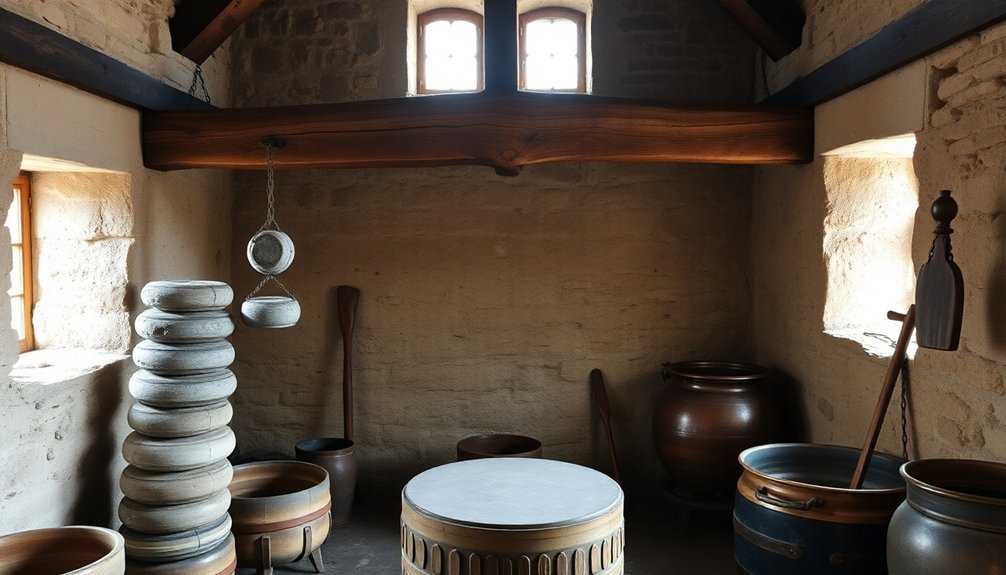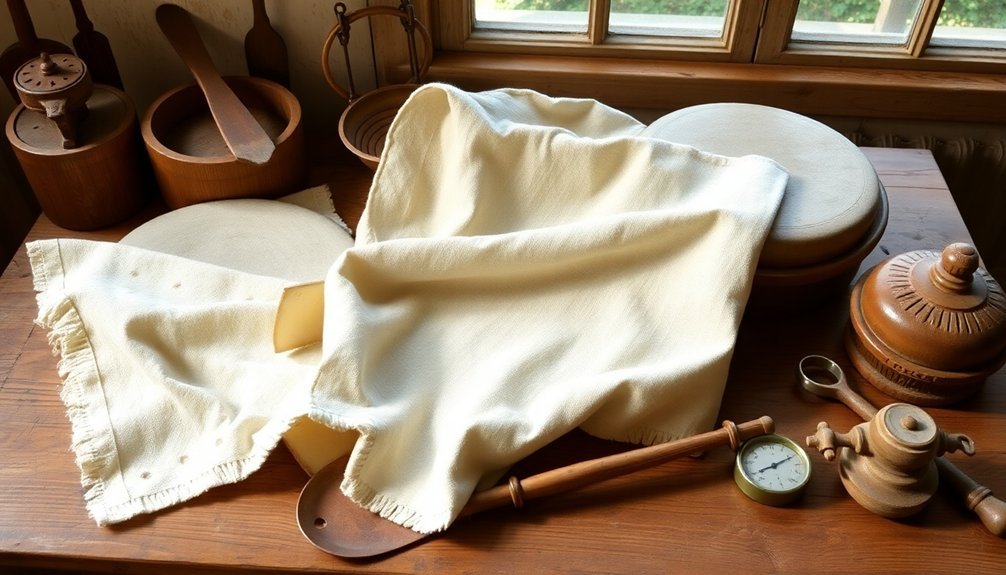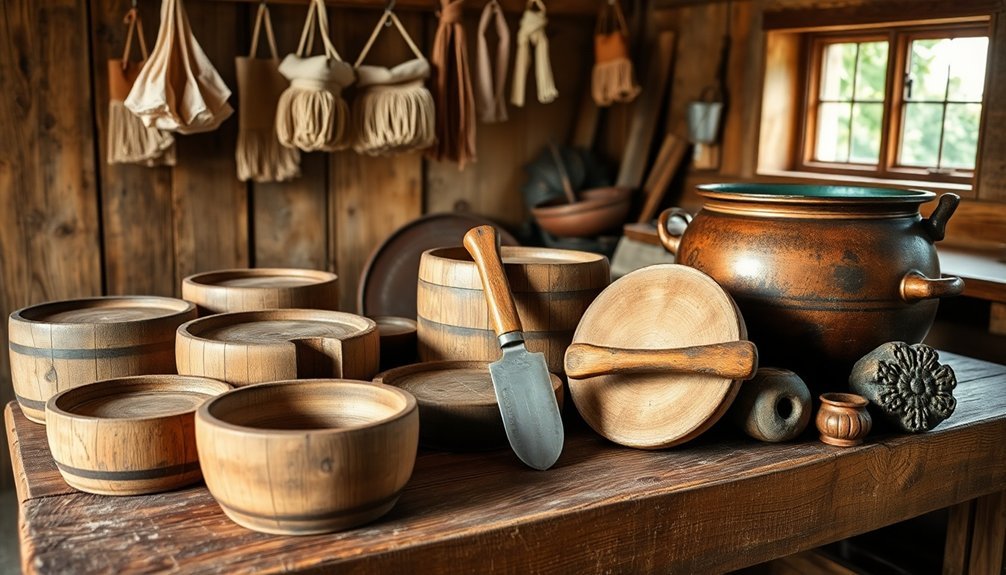Seven foundational tools have revolutionized artisanal cheesemaking throughout history. You'll discover that ancient animal stomach vessels first enabled milk coagulation around 8,000 BC, while woven baskets and pottery molds shaped curds and allowed whey separation. Stone and beam presses applied consistent pressure for harder cheeses, and traditional hickory wood tools provided gentle mixing. Linen cheese cloths offered durability and proper drainage, while copper kettles guaranteed even heat distribution. Monastic equipment, from wooden molds to specialized curd knives, refined the craft into an art form. Each tool's story reveals the fascinating evolution of this time-honored tradition.
Ancient Animal Stomach Vessels

Ancient shepherds stumbled upon one of humanity's most important food discoveries when they stored milk in vessels made from animal stomachs. When they stored milk in containers crafted from sheep's and goats' stomachs, they noticed the milk would transform into a yogurt-like substance that could be further processed into cheese. This accidental discovery, dating back to around 8,000 BC, revolutionized how humans preserved dairy products.
The secret lay in the unique properties of ruminant animals' stomach linings, particularly the fourth stomach (abomasum), which contains special enzymes called rennet. These enzymes, primarily consisting of proteases like chymosin, naturally activate in acidic conditions and cause milk proteins to coagulate. This traditional method using animal rennet remained the primary cheese-making technique until recent centuries.
When shepherds stored milk in these stomach-derived vessels, the rennet would transform the liquid into solid curds and liquid whey.
You'll find evidence of this breakthrough in ancient Egyptian tomb drawings and Greek texts, showing how this discovery spread across civilizations. The technique proved invaluable, as it allowed people to create a nutrient-rich food that could be stored and transported over long distances without spoiling.
Woven Baskets and Pottery Molds
You'll find that both woven baskets and pottery molds served as essential draining tools in early cheesemaking, with each offering distinct advantages for whey separation.
The regional variations in design reflected local materials and traditions, from the reed baskets that created the distinctive patterns of Sicilian Canestrato to the precisely-holed ceramic molds favored by Roman cheesemakers. Archaeological evidence reveals that these tools were widely used in ancient Mesopotamia's cheesemaking, dating back over 7,200 years.
While baskets could hold more curd and offered superior drainage through their woven patterns, pottery molds provided better curd retention and were easier to clean, leading many artisans to keep both tools in their workshops.
Early Draining Techniques
Throughout the earliest days of cheesemaking, humans relied on two primary tools for draining: woven baskets and pottery molds. These simple yet effective tools played a vital role in transforming milk into cheese through natural drainage processes. Modern cheesemakers still value similar slow drainage techniques for optimal results.
You'll find evidence of this in ancient Mesopotamian friezes dating back to 3,000 BCE, where pottery molds were depicted in early cheesemaking scenes.
Woven baskets, crafted from local materials like reeds and natural fibers, allowed whey to drain naturally from the curds while simultaneously shaping the cheese. You'd notice distinctive patterns on the cheese's surface, created by the basket's weave.
Similarly, pottery molds helped contain and shape the milk as it curdled from heat exposure, whether from the sun or cave fires.
Three key advantages of these early draining techniques:
- Required minimal technology, making cheese production accessible to early civilizations
- Provided consistent results through natural separation of curds and whey
- Utilized readily available local materials, ensuring sustainable production methods
These foundational tools laid the groundwork for modern cheesemaking, though they've largely been replaced by standardized industrial equipment.
Regional Design Variations
Regional variations in cheesemaking tools reveal fascinating cultural adaptations across different territories. You'll find distinct designs in both woven baskets and pottery molds, each tailored to local traditions and cheese varieties.
In Sicily, specialized craftsmen called fiscellari create baskets specifically for Canestrato cheese, while Roman-inspired designs, based on Pompeii artifacts, serve different regional needs.
The baskets you'll encounter vary by region, with traditional versions made from local materials like reeds and giunco. These tools aren't just functional – they're integral to cheese characteristics, as their wicker patterns create distinctive striations on the cheese's surface.
When you compare them to pottery molds, you'll notice how ceramic versions, modeled after Roman specimens from the Ashmolean Museum, offer better curd retention and temperature control.
Southern Italian regions like Sicily and Sardinia have adapted these ceramic molds for their Pecorino Romano production.
While modern adaptations include plastic versions of traditional basket designs, there's an ongoing effort to preserve authentic crafting techniques, especially in rural areas where these tools continue to shape local cheese varieties.
Stone and Beam Presses

Since the dawn of organized cheesemaking, stone and beam presses have served as essential tools in the craft's development. You'll find evidence of these ingenious devices dating back 8,000 to 10,000 years, with their use continuing through the pioneer days of Wisconsin in the 1840s.
These simple yet effective presses consisted of wooden beams filled with stones, creating consistent pressure to separate curds from whey.
When you're examining the functionality of these historic tools, you'll notice they were remarkably efficient despite their primitive nature. Cheesemakers would strain curds through linen or cheesecloth, then apply pressure using the stone-weighted beam. They'd even use their bare hands as natural thermometers during the warming process.
Here are three key impacts these presses had on modern cheesemaking:
- They established the fundamental principle of pressure application that's still used in today's cheese production.
- They helped pioneer regions like Wisconsin become major cheese-producing areas.
- They laid the groundwork for the shift to centralized cheese factories in the 19th century.
Local materials and simple construction made these presses accessible to early cheesemakers, contributing greatly to the craft's evolution.
Hickory Wood Mixing Tools
Early American cheesemakers relied heavily on hickory wood to craft their essential mixing tools, a practice that flourished particularly in Wisconsin's pioneering days.
You'll find that these resourceful artisans chose hickory for its remarkable durability and widespread availability, often crafting their own implements when proper equipment was scarce.
If you'd explored a 19th-century cheese operation, you'd have seen an array of handmade hickory tools, from sturdy mixing paddles to carefully constructed hoops for cheese molds.
The wood's exceptional hardness made it perfect for creating equipment that could withstand the rigors of daily cheesemaking. These tools weren't just practical; they were essential to the survival of farmstead cheese production.
You'd discover that hickory's versatility extended beyond just mixing tools.
Cheesemakers and local craftsmen would fashion complete sets of equipment, including cheese presses and molds, from this robust wood.
When you consider the primitive conditions these pioneers worked in, you'll appreciate how hickory's strength and workability made it an invaluable material in early American cheesemaking, enabling them to maintain consistent production despite limited resources.
Traditional Linen Cheese Cloths

While hickory tools shaped the solid components of cheesemaking, the humble linen cloth played an equally significant role in the craft's development.
You'll find that early cheesemakers, particularly pioneers in Wisconsin, turned to linen as a practical substitute for traditional cheesecloth, utilizing its loose weave and durability to separate curds from whey.
The production of these essential cloths began with flax plants, taking roughly 100 days to mature before harvest. Once the stalks were processed and broken down, the resulting fibers were carefully combed and spun into yarn, creating a breathable fabric that would serve countless batches of cheese.
- Linen's natural qualities made it ideal for cheesemaking, as its loose weave allowed whey to drain while keeping curds intact.
- The fabric's durability meant you could wash and reuse it multiple times, making it an economical choice for early settlers.
- Its breathability contributed to proper cheese curing, maintaining cleanliness while allowing essential airflow.
This adaptable textile demonstrates how early cheesemakers innovated with available resources, transforming simple materials into essential tools of their craft.
Copper Kettles and Boilers
Few tools have shaped artisanal cheesemaking quite like copper kettles and boilers. You'll find these gleaming vessels at the heart of many historic cheese plants, particularly in the Alps and Switzerland, where they've been instrumental in crafting iconic cheeses like Parmigiano Reggiano, Emmental, and Gruyere.
When you're working with copper kettles, you're benefiting from their exceptional heating properties. The material heats evenly throughout, ensuring your cheese develops consistently. What's more, copper contributes trace amounts of the metal to your cheese, enhancing flavor profiles while maintaining higher pH levels that help retain essential minerals in the milk.
You'll need to maintain these kettles carefully, though. They require specific cleaning protocols and careful attention to pH levels during the cheesemaking process. If you're operating in states like Wisconsin, you'll also need to follow specific regulations regarding copper-lined vats.
Modern copper kettles haven't lost their traditional charm, but they've gained new features. You can now outfit them with digital controllers, energy-saving designs, and variable speed stirrers.
These innovations let you combine time-honored craftsmanship with contemporary efficiency, ensuring your cheese meets both traditional standards and modern demands.
Monastic Cheesemaking Equipment

Medieval monasteries revolutionized cheesemaking with their specialized equipment and dedicated spaces.
You'll find that monks developed extensive facilities where professional cheesemakers, primarily women, used specific tools to perfect their craft. In these self-contained communities, they utilized wooden and pottery molds, alongside basic implements like colanders and baskets, to separate curds from whey.
The monastic dedication to cheesemaking required a precise set of tools, including thin stainless steel curd knives for handling the curds and skimmers for mixing cultures and additives.
They'd employ cheese cloths with colanders and apply careful pressure within molds to achieve the desired consistency. These tools were essential in their dedicated cheese rooms, where they'd create both hard and soft varieties using sheep's and cow's milk.
- Tools evolved from simple baskets to specialized molds, reflecting the monks' commitment to improving cheese quality
- Equipment selection varied by region and cheese type, with specific tools for hard cheeses like Cheddar versus soft varieties like Brie
- The combination of proper tools and controlled aging environments allowed monks to develop distinctive cheese varieties that we still enjoy today
Frequently Asked Questions
How Did Early Cheesemakers Determine the Optimal Temperature Without Using Thermometers?
You'd rely on touch, sight, and experience to gauge milk temperature. You can observe curd formation, feel milk's warmth, use natural heating methods, and follow traditional knowledge passed through generations of cheesemaking.
What Natural Preservatives Were Used Before Modern Refrigeration Methods?
You'll find that salt was the primary natural preservative, along with raw milk's native cultures. Aging cheese in caves and using wood boards helped preserve it, while natural rennet and wine washing provided additional protection.
How Long Did Traditional Cheese Aging Processes Typically Take?
You'll find traditional cheese aging varied widely: soft cheeses like Brie took just 2-4 weeks, while hard cheeses like Parmesan needed 10-24 months. Some exceptional cheddars were even aged for decades.
Which Specific Woods Were Considered Toxic for Making Cheese Tools?
You'll want to avoid Yew, which can cause deadly cardiac effects, along with Milky Mangrove's poisonous sap. Brazilwood and European Boxwood are also toxic, causing severe allergic reactions and respiratory problems.
How Did Seasonal Changes Affect the Choice of Cheesemaking Tools?
You'll need to adjust your tools based on milk's seasonal composition. In spring/summer, you'll use larger tools for higher yields, while autumn/winter requires gentler tools to handle weaker curds and lower volumes.
In Summary
You'll find that these seven historic tools laid the foundation for modern artisanal cheesemaking. Whether you're examining ancient stomach vessels or monastic equipment, you can trace today's craft directly to these innovations. As you explore the rich heritage of cheesemaking, you'll see how each tool contributed unique qualities that artisans still value. These time-tested implements continue shaping the way you experience handcrafted cheese today.





Leave a Reply